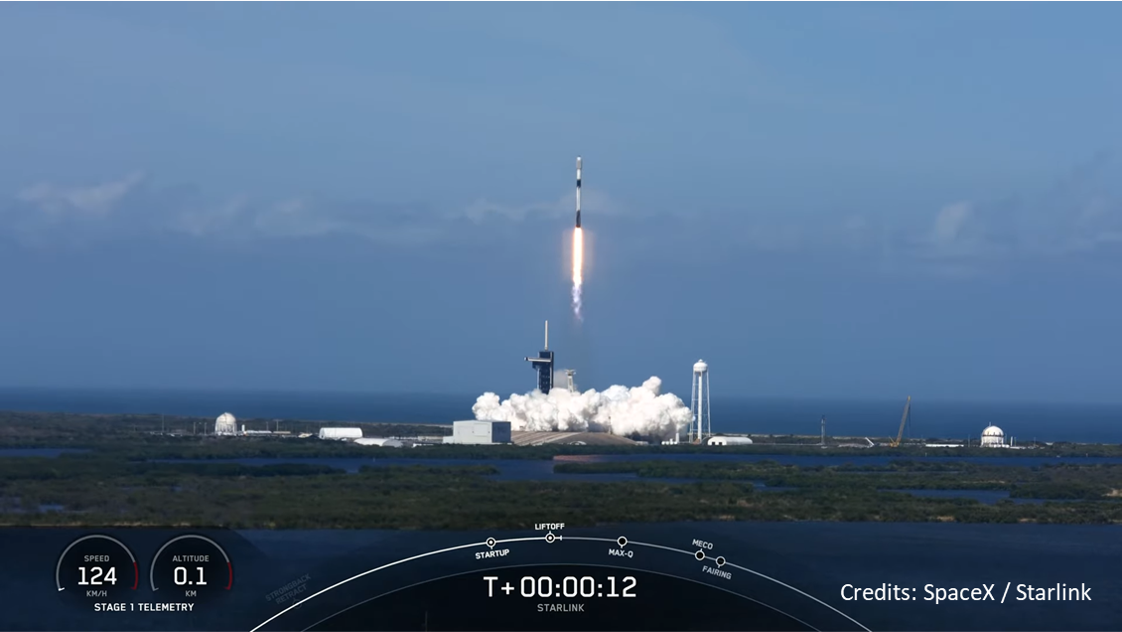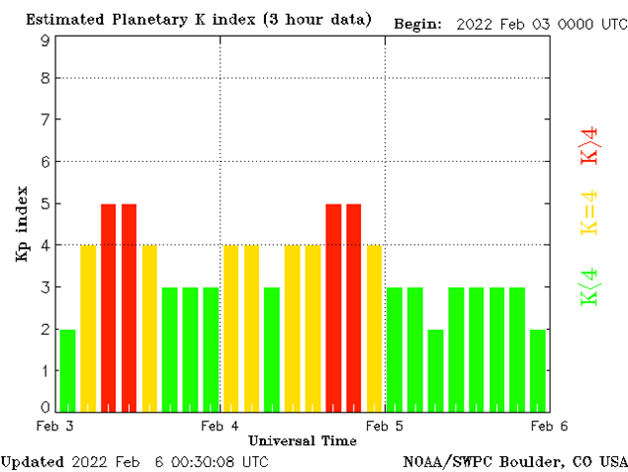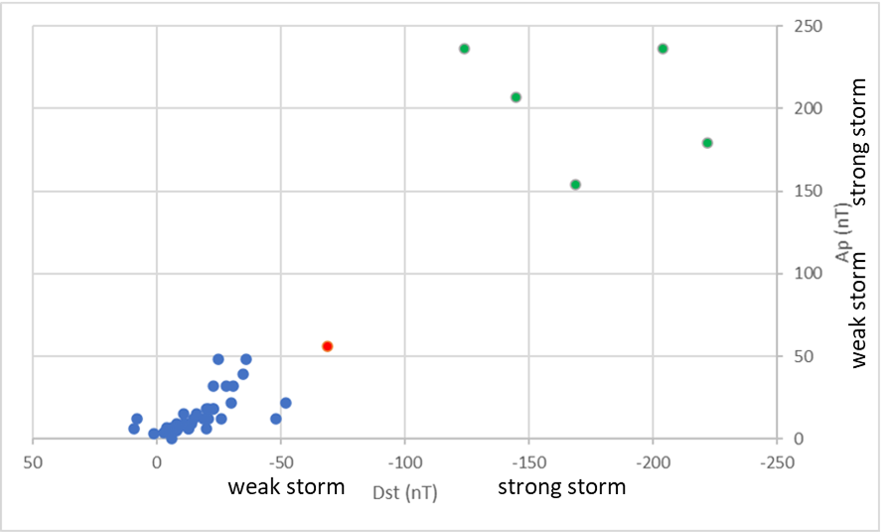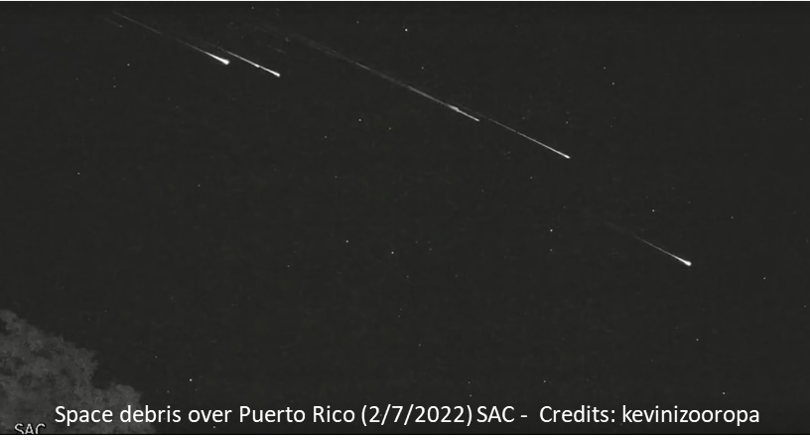The space weather community was surprised last week when SpaceX announced it had lost up to 40 of its 49 Starlink satellites (see Note 1) that were launched from the Kennedy Space Center, Florida on 3 February. A screenshot of the launch from their live broadcast can be seen underneath, with a recording available at the SpaceX launches webpage. The problems were encountered the day after launch, on 4 February, following a geomagnetic storm. However, only minor storming was recorded on 3 and 4 February, and that usually does not result in severe space weather impacts. So, what was going on?

Let's first take a more detailed look at the geomagnetic conditions during launch day and the day after. On 3 February, a coronal mass ejection (CME) hit the earth environment resulting in episodes of minor storming (Kp = 5) that day and the day after. The Dst-index reached moderate levels, resp. with -77 and -69 nT on 3 and 4 February. More on these indices and levels of geomagnetic activity can be found at the STCE's SWx classification page. This storm had only minor to moderate strength, but one may note that geomagnetic activity was at active to minor storming levels for most of these days. So, the storm did not concern just a single, isolated period, but rather a sustained period of enhanced geomagnetic activity (see e.g. Oliveira et al. 2020). This can be seen underneath in NOAA's estimated Kp index for those days.

The geomagnetic levels reached on 3 and 4 February have been observed already several times in the past, and they usually are no cause of strong space weather impacts. So, maybe these conditions were out-of-the-ordinary for this Starlink launch? Including its test satellites, SpaceX has been launching these artificial moonlets since 2018, so the geomagnetic conditions for those more than 30 previous launches were quickly checked. The graph underneath shows the minimum Dst and maximum Ap 1 day after launch (blue dots). As can be seen, The 4 February 2022 operations (1 day after launch ; red dot) clearly took place during geomagnetic conditions not encountered so far by the Starlink fleet. That's no surprise, as most of the launches took place during solar cycle minimum. On the other hand, it's clear that this was not an extraordinarily strong storm. To illustrate this, a few of the strongest geomagnetic storming days of the previous solar cycle (SC24, green dots) were added and can be seen in the upper-right corner of the graph.

The course of events on that fatal day was explained by SpaceX in their 8 February communication. Shortly after launch, the satellites were put -as usual- in a stand-by orbit with a perigee (point closest to Earth) of 210 km, before being transferred to their final orbit at 540 km altitude. Note 210 km is just above the minimum orbit altitude for a satellite, which is grosso modo 180 +/-20 km pending size and shape of the satellite. SpaceX does this on purpose, because in the very rare case a satellite does not pass the initial system checkouts, it will quickly be deorbited by atmospheric drag (friction between the atmosphere and the satellite; see the related STCE news item).
As it happened, the satellites were at this low altitude portion of their orbit manoeuvre when the geomagnetic storm occurred. Onboard GPS suggested the strength of the storm caused atmospheric drag to increase up to 50 percent higher than during previous launches. The Starlink team then took the decision to let the satellites go into safe mode which allowed them to fly a path that minimized drag. However, the encountered drag remained high preventing to leave safe mode and to start the orbit raising procedures. A number of the affected Starlink satellites seems to have already re-entered the Earth's atmosphere, see e.g. this YouTube video showing deorbiting Starlink satellites burning up in the earth's atmosphere (screenshot underneath). The deorbiting satellites pose zero collision risk with other satellites and by design demise upon atmospheric reentry, meaning no orbital debris is created and no satellite parts hit the ground.

It's amazing that such a small storm can wreak so much havoc. With solar cycle 25 (SC25) just starting its increase towards its maximum in 2024, geomagnetic conditions such as those experienced on 3 and 4 February will become much more frequent and thus increase the risk on more Starlink satellite fatalities in years to come. If the transfer orbit is maintained at the current altitude of 210 km, best practice would be to try and launch during quiet solar and geomagnetic periods. The SIDC SWx forecast centre issues daily space weather bulletins and alerts, including an "All Quiet Alert" (valid for the next 48 hours) in case solar flaring is expected to stay below C-class level, no proton events are in the offing, and at the same time geomagnetic activity is forecasted to stay below storming levels (Kp < 5). These conditions (all 3 together) do not happen very often during a solar cycle maximum, so best practice would be to keep an eye on the daily space weather bulletins.
This article was written with the kind contribution from Dave Pitchford (SES).
Note 1: In the end 38 Starlink satellites re-entered the Earth's atmosphere (Kataoka et al. 2022 ; Dang et al. ; 2022).





